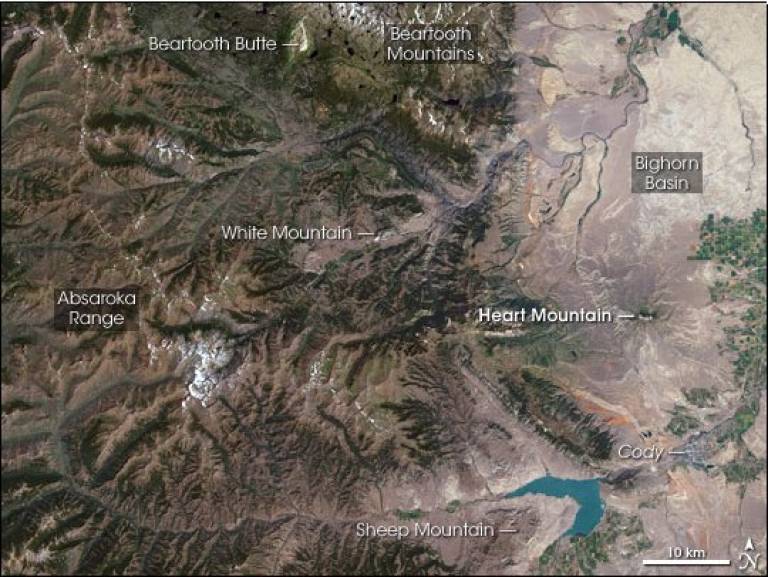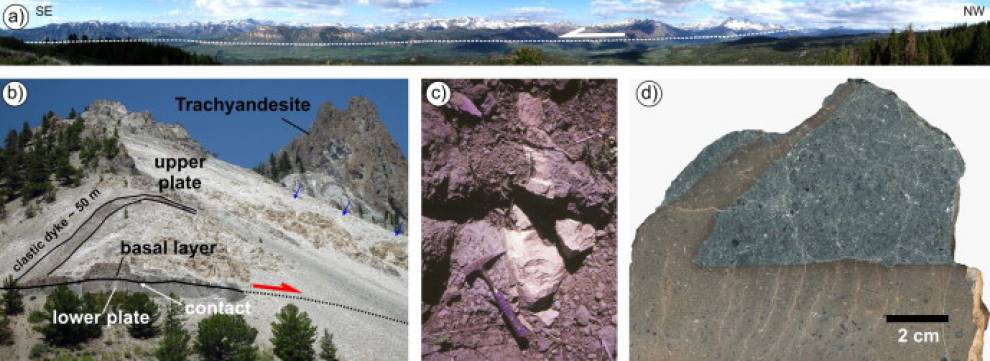World's Biggest Landslide Floated Like a Hovercraft
21 January 2015
he Heart Mountain landslide of northwest Wyoming is the largest known sub-aerial landslide on Earth. During its emplacement more than 2000 km3 of Paleozoic sedimentary and Eocene volcanic rocks slid >45 km on a basal detachment surface dipping 2°, leading to 100 yr of debate regarding the emplacement mechanisms. "Even I have a hard time visualizing a mountain moving 50 kilometers, but you can move it if the friction is low enough," said lead study author Tom Mitchell.

 |
| Figure Captions: (a) Photograph of ∼30 km of the Heart Mountain slide block (B to B′B′ in Fig. 1). View looking southwest from south flank of the Beartooth Mountains. Photograph is by Anna Foster with her permission. (b) White Mountain sampling site. White rocks are upper plate marbleized Ordovician Bighorn Dolomite and Mississippian Madison Limestone. The gray horizontal layer is the ∼3 m-thick basal layer overlying a thin sliver of the lower plate Bighorn Dolomite and Cambrian Snowy Range Formation. The dark trachyandesite peak in the upper right is an Eocene stock of the Absaroka Group Volcanics. Marbleization is due to stock igneous intrusion prior to slide emplacement. Modified from Anders et al. (2010). (c) A clastic dike/injectite at Silvergate, Montana (light colored injectite is intruded into dark Eocene Absaroka Volcanic rocks). This dike is located within a meter of the basal contact. At this location carbonized Eocene wood was found in the dike (see Anders et al., 2010, their Fig. 3f). (d) Cut slab of clastic dike/injectite from Silvergate, Montana location. |
Now, laboratory experiments on limestone and dolostone rocks from the landslide seem to support the idea that the landslide slid catastrophically fast. In the tests, conducted at INGV Rome's specialized laboratory, Mitchell and his colleagues ground together limestone and dolostone at high pressures and speeds to mimic the landslide. Almost as soon as the experimental landslide started, the rocks started to break down and release carbon dioxide gas.
"You can produce these gases early on, at the very early stages of landslide slip," The gas cushion, trapped between the landslide block and rocks underneath, could have lifted the heavy limestone and reduced friction to nearly zero, according to the study, published online Dec. 23, 2014, in the journal Earth and Planetary Science Letters. "It's almost like it's weightless," Mitchell said.
Recently, emplacement by catastrophic sliding has been favored, but experimental evidence in support of this is lacking. In his work, Michell and Colleagues show in friction experiments on carbonate rocks taken from the landslide that at slip velocities of several meters per second CO2 starts to degas due to thermal decomposition induced by flash heating after only a few hundred microns of slip. This is associated with the formation of vesicular degassing rims in dolomite clasts and a crystalline calcite cement that closely resemble microstructures in the basal slip zone of the natural landslide. Their experimental results are consistent with an emplacement mechanism whereby catastrophic slip was aided by carbonate decomposition and release of CO2, allowing the huge upper plate rock mass to slide over a ‘cushion’ of pressurized material.
Related Links:
1. Catastrophic emplacement of giant landslides aided by thermal decomposition: Heart Mountain, Wyoming by Michell T. M et all. Earth and Planetary Science Letters. 2015 vol. 411
2. World's Biggest Landslide Floated Like a Hovercraft by Becky Oskin, Live Science 2015 Jan.
3. Seismolab
 Close
Close

